Part 2 of the refit series: Superb-Us
If it looks right, it is right – well, it will be at the Brixham Trawler Race!
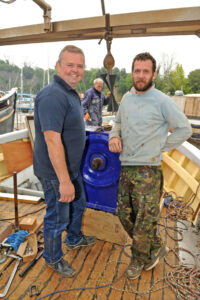
Skipper Alan Steer (left) and crewman Simon Evans alongside the Celtic slave console, which has been lifted by 6in.
Without doubt, the boatbuilder’s number one rule, and particularly so in building wooden craft, is, ‘if it looks right, it is right’.
A host of boats in the South West certainly meet that rule, like those recently refitted at the Dartside Quay Marine Service Centre on the river Dart near Galmpton, including Superb-Us DH 99, Excel DH 17 and Tenacious DH 95.
Together with so many more – like Bosloe PH 122, Galwad-Y-Mor of Lymington SU 116, Celtic Mor DH 43 and William Henry DH 5 – the list goes on. Not that long ago, wood was the first choice of many skippers. Larger wooden vessels were built by craftsmen at yards like Mashfords at Cremyll, J Hinks & Son at Appledore, C Toms & Son, Percy Mitchell & Son and John Moor & Son in Cornwall, and also Cann & Pender at Galmpton in Devon.
Other yards in Devon, like Dixon & Son at Exmouth and HJ Mears & Son at Seaton, are just two of many that over the years have turned trees into works of art – vessels from which the incomes of so many fishermen are still being made.
Sadly, some of those yards have gone, but the remaining ones, like C Toms & Son and Bobby Cann (with his staff of six), and John Moor’s yard at Mevagissey, still have the skills in wooden boatbuilding. The trend today is for new-builds to be made in steel, much to the sadness of Bobby Cann, who would, before retirement, like to build a wooden fishing boat like his last wooden construction, Trevose PW 64. In all likelihood, Bobby Cann will never retire, so there is a high chance of that occurring!
Let’s not believe that wooden boatbuilding is over, because in sectors other than fishing, there are shipwrights at places like Gweek Quay Boatyard in Cornwall busy making traditional wooden yachts. Fine examples of their workmanship are in increasing demand.
Say the words ‘Superb-Us’ to almost any fisherman from the South West – or east past the Isle of Wight, the Channel Isles, and further afield – and few would present a blank face. The Superb-Us is a landmark in the history of South West potting.
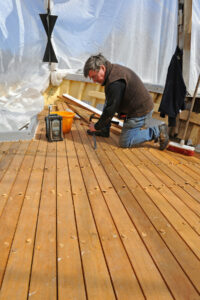
Bobby Cann at work on the new opepe hardwood-planked deck now in place on the Dartmouth crabber Superb-Us.
Wooden boats have a habit of stamping their mark in history books; Superb-Us and its sistership Bosloe being perfect examples. Now skippering the Superb-Us, Alan Steer, together with his father – retired skipper Winkie Steer – kindly allowed me to dig into the boat’s history.
I’ve known Winkie Steer from when Alan was a youngster, working on the Superb-Us to develop his career as a very successful inshore skipper. In fact, I don’t know of any time when I have seen either Winkie or Alan Steer aboard any boat other than Superb-Us.
Superb-Us is set for another long haul before its next ‘fairly big refit’, said Bobby Cann who, with his workforce including apprentice Ben Fowler, spent considerable time bringing Superb-Us back to ‘as good as new’.
He explained: “From stem to stern, all the deck was taken up. We have replaced three of the deck beams, three new stanchions, quite a few small jobs, too – and like always, do one task and you see others that need doing – but generally, all of that work was minor. All jobs in the refit came from repairs and maintenance, as expected with the wear and tear on such a boat.
“The condition of all the woods are good; the boat was built – larch on oak – during 1963 at Mashfords. We replaced the deck simply because it was time to do so; the work has been planned for three years. We have looked after the Superb-Us for about 15 years. It is a fine boat, a good wooden boat.
“The new deck is made of 400mm x 50mm planking of opepe. All the fastenings are galvanised, and the seams are all pitched.” Opepe is a hardwood grown in Western Africa. In addition to its hardwearing qualities, opepe is particularly resistant to shock loads, and is commonly used in the marine industry.
“Nothing was necessary to do in the engineroom, but because the hull was opened up, it enabled the inner hull to be dried out, and all compartments were cleaned throughout. The propeller was rebalanced and made good by C&O Engineering, before Superb-Us was relaunched as – generally – a new boat. I know that I repeat it so often, but it is beyond me why people no longer consider wood as a material with which to build a boat. Nothing else would stick the amount of time of hard work that a fishing boat does – without having serious hull problems.”
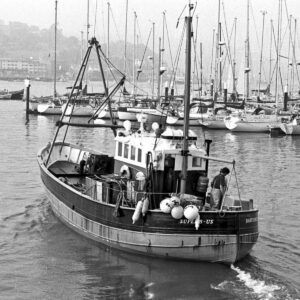
Superb-Us in 1986.
Many people say that the lifespan of a well-cared-for wooden boat will outstrip that of a steel boat.
Alan Steer gave me a rundown on the history of Superb-Us. “Originally, it was built for the Browse brothers at Paignton – built for Ken Browse, I believe. He had the boat for two years before it was sold to two brothers in North Devon. Quite soon after, it went back on the market in 1968, and my father had always wanted a boat of that type, so he bought it. Several years ago, father passed Superb-Us on to me.
“As a youngster, I spent a lot of time on the boat, and in 1987, I went to Falmouth College for the fishing course. I completed that and returned full-time with father, and have been on the Superb-Us ever since. I have done stand-in days on other boats, but never full-time.
“Bosloe was built two years after Superb-Us, and it is slightly different. On building the hull of Superb-Us, they had to tightly tuck the planks in at the stern – so tight that it was harder work than they expected – so the Bosloe is slightly more let-out at the stern than the Superb-Us is.
“In my opinion, you just cannot beat a good, classic wooden boat. They are excellent sea boats, and it would be difficult for me to choose steel instead. If I had no option, I suppose I would choose steel, but I would truly miss having a wooden boat. I’m not really sure whether I would choose fibreglass, but thankfully, it’s a choice I don’t have to make. I think it just depends on where you have to fish. If you’re fishing way offshore, then it would have to be a boat made from steel, but we don’t go any more than six miles offshore – day-tripping only – and both my crewmen and I like that sort of life.
“We work 600 pots a day, all being 26in-diameter plastic inkwell pots. All come from Mike Cornish. In early years, we used the 30in plastic inkwells, but for what we do, the 26in-diameter inkwells are better. We have tried creels; we still have a string of 30 creels, but in our area, they don’t seem to work as well on crab. Perhaps a creel is good for lobster – but we don’t target lobster.
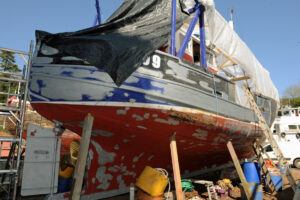
It was a big refit, but no major work was necessary to the hull.
“Yes, we still have the same original 6LXB Gardner engine. From the crankshaft up, 13 years ago, Paul Gardner rebuilt the engine. He said it was the last true six-cylinder marine engine that Gardner ever built. From 1964 to 2006, no major work was carried out, and it has hardly seen a spanner since. All through its life, the engine has only had standard maintenance and oil changes. It doesn’t use much fuel – about 100 litres per day would be a lot. The top steaming speed is about 8.5 knots, and that’s plenty.”
Alan’s father Winkie Steer explained: “When we collected the engine after its rebuild, Paul Gardner said to me, ‘There you are, boy, because of the modern metals, that engine is better now than when it was made.’ It probably is.
“Look at the economy – I know it is an old-style engine, but look how little fuel it drinks, and how much upkeep there is. No, we wouldn’t change it unless we really had to. Hopefully, it will go on for many years to come.”
Alan Steer continued, “As well as work to the deck, we had the rudder area looked at. Bolts where the rudder stock rises through the deadwood were not tightening properly, so a strong stainless steel capping has been inserted, to which the rudder stock is now firmly bolted down.
“We have raised the Celtic slave console by 6in, just to make it more comfortable to use. When father had the boat originally, it had a capstan hauler, so when the Celtic slave took its place, it was a bit too low. Other than that, there were no more alterations to the boat. It’s so good to have the new deck, because the previous fixings were tired and there were slight leaks.
“All in all, we are really pleased with Superb-Us. Just for the safety aspect, we are having railings fitted later this year, but I wouldn’t change anything on Superb-Us – it’s just right for what we want.”
Bongos? What’s a bongo?
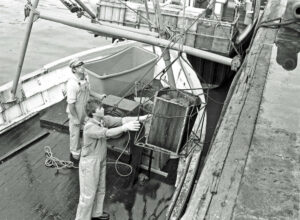
The odd few tea chests made it right through until 1986, and here, young Alan Steer is offloading good hen crab from Superb-Us.
For many years aboard a day-boat, crabs were stored in old tea chests – the thin plywood boxes used for carrying all types of raw leaf tea. Tea being used in tea bags hadn’t really caught on, and finding old tea chests wasn’t that difficult. But using tea bags gained in popularity.
So, as years went by, finding tea chests was like finding gold dust, so an alternative had to be found. The bongo was an obvious choice – wasn’t it?
Over the entire UK, the word ‘bongo’ is now part of a shellfisherman’s language – and we even have purpose-made square plastic bongos from a firm like Mustang Engineering – but where did that word ‘bongo’ come from?
Winkie Steer may know the answer – it came from a South Devon shellfisherman, Terry Ekers, he reckons.
Winkie Steer explained, “I’m pretty sure that the word came from Terry who, like me, was a skipper back in the late 1960s. At a time when you had to store crabs in old tea chests, a chest would take about 120lb of crab – about 50kg.
“In those days, we would get 35 chests of crab from 320 pots, so we needed quite a few chests, but we could never get enough tea chests. It was a real problem, and it got worse because more people were buying tea bags! Tea chests went on for a while after that, but not far beyond the early 1980s.
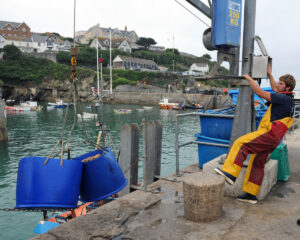
Bongos of brown crab being landed at Newquay.
“I can remember, one morning on VHF Channel 6, Terry Ekers was going on about having found something shaped like a bongo drum. Terry was always on the radio; every morning, he would have something new to tell us, so at first, we all thought it was just him chattering away. But eventually, I had to answer back when he said, ‘Guess what us has got today? We haven’t got chests, we’ve got bongos.’
“We thought he’d gone bonkers, and asked him what on earth he was talking about. ‘What’s a bongo?’ I asked.
“Terry came back saying, ‘These are just like bongo drums – just what we want, open at one end. We won’t need tea chests any more.’ From somewhere, Terry had found metal drums instead of plywood tea chests. So I reckon the word ‘bongo’ came from Terry Ekers!”
And I reckon Winkie is right – and that word is perfect for today’s ‘bongo’ – a chemical drum cut down the centre.
For the layman: a bongo today is a plastic container of about 100 litres in capacity. In truth, it’s just half a drum, made by cutting a standard 200-litre plastic chemical storage drum in two – so we get two ‘bongos’ every time!
And believe me, if you ‘find’ the drums on a farm, when you chop it in two, you ruin whatever clothes you have on, unless you wash the hypochlorite out first!
And once the bongos are made – and holes in the top of each are drilled for rope handles – you have to get a permanent marker or an old soldering iron and burn your numbers on the bongos’ side to stop them being ‘borrowed’.








